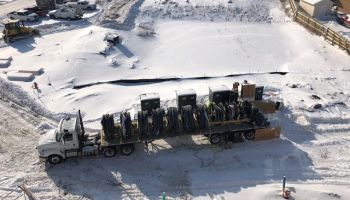Don’t get caught out in the cold. Tips for pulling wire in cold weather.
- January 7, 2025
- Video
- Electrical

As we’re sure you’ve noticed, winter is in full effect: cold temperatures, ice-covered windshields, and snow-covered walkways. This time of year, it’s important to take outdoor temperatures into consideration during many activities, including wire pulling and cable installation.
The Impacts of Cold Temperatures on Cables
Cold temperatures place extra strain on cables, causing them to temporarily become brittle and inflexible. Below a certain temperature, it becomes difficult for cables to retain their flexibility and plasticity while being bent. PVC jackets, for example, will stiffen and potentially crack with the slightest touch or movement if they aren’t pulled at or above recommended temperatures.
These conditions can lead to difficult installation. If a crew starts pulling wire without taking the proper precautions, the jacket and/or insulation may become damaged.
Minimum installation temperature ratings for different cable types indicate the lowest temperature recommended for wire pulling. To make sure cable can withstand the rigors of installation and last its expected lifespan, make sure to follow these recommended ratings.
What is the lowest temperature recommended for pulling wire?
| Type of Wire Installation | Minimum Installation Temp. |
|---|---|
| Copper THHN | 14° F |
| Copper XHHW | -40° F |
| Copper USE | -40° F |
| Aluminum THHN | 14° F |
| Aluminum XHHW | -40° F |
| Aluminum USE | -40° F |
| Copper 15kV 220 Mil EPR 133% | 14° F |
| Aluminum 15kV 220 Mil EPR 133% | 14° F |
What You Can Do to Protect Cables (and People)
How to protect your wire for cold weather installations
The onset of winter weather doesn’t mean you can’t continue to install cable. There are simple steps you can take for protection:
- Store cable indoors whenever possible
- If cable can’t be stored indoors, move cable reels into a heated area 24 hours before installation to allow heat to penetrate the reels’ cable layers
How to protect cable from cold weather during transport
Once you’ve kept your cable inside for 24 hours ahead of time, but what do you do to keep it warm when you have to load it onto a truck and transport it through the cold? Covering cables with concrete blankets during transit keeps your wire insulated from the cold and helps protect it from moisture and debris. You can find concrete blankets at most big box home-improvement stores.
How to protect your workers on freezing job sites
These temperatures can also be tough on installers, too. Keep them safe by encouraging them to:
- Drink fluids and stay hydrated
- Get enough sleep so they’re alert during the day
- Remove wet clothes immediately to prevent accelerated heat loss and impaired movement
- Wear proper winter clothing (loose-fitting layers) and insulate head and neck areas well
- Add layers as activity levels decrease and remove layers as activity levels increase
If you have questions about pulling wire in cold temperatures, give us a call at 800-247-1410. We’re happy to answer your questions!

ARTICLE BY:
HEATHER MCDONALD
EMPLOYEE-OWNER, SOUTHWIRE SOLUTIONS SPECIALIST